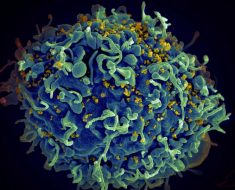When is a baby’s head TOO big? As Paris Hilton’s son is mocked by cruel online trolls, research shows one in 50 newborns have condition… and it can be deadly for one in 1,000
- The clinical term for a big head is macrocephaly and it occurs in 2% of babies
- It’s generally harmless but could indicate severe problems like fluid on the brain
- READ MORE: Paris Hilton hits back at ‘sick’ trolling of her baby son Phoenix
Paris Hilton hit out against cruel trolls this week who mocked her baby son’s ‘deformed’ head and likened him Family Guy’s Stewie.
Other, ostensibly concerned, fans urged the socialite to take nine-month-old Phoenix to see a neurologist for a brain scan.
But babies with big heads are not uncommon. Roughly one in 50 babies are born with macrocephaly, a scary-sounding word that just means large head.
The vast majority of macrocephaly cases are harmless, but some could be the result of a more dangerous underlying cause, such as hydrocephalus, or excess fluid around the brain, which affects roughly one in 1,000 children.

Paris Hilton defended herself and her infant son from internet bullying by some who say baby Phoenix’s head is abnormally large and could indicate a health problem

She said that Phoenix has seen a doctor, who would measure the infant’s head as party of at least seven regular well visits during a child’s first year of life. It is in these doctor visits that a potential problem could be noted
During their first year, babies typically see pediatricians for well visits seven times.
Each time, the doctor takes measurements of the baby’s head to spot potential neurological problems, meaning any potential warning signs would likely be identified by the experts by the time a baby like Phoenix reaches nine months old.
About two percent of babies have macrocephaly, defined as having a head circumference greater than two standard deviations above the average for gestational age and sex.
In simpler terms, it means the baby’s head is larger than 97 percent of other infants’ heads. Around half of all cases can be chalked up to big heads running in the baby’s family.
The pediatrician will measure the baby’s head circumference at every check-up until they reach three years of age.
If repeated measurements confirm macrocephaly, the doctor will then turn their attention to the parents, measuring their heads to determine whether the infant’s large cranium is a product of genetics.
If parents or other family members have large heads, the odds are greater that the baby’s head will be larger too.
But if genetics are ruled out, the doctor will typically order an ultrasound on the baby to see if there is any buildup of cerebrospinal fluid (CSF) around the brain, and potentially more tests such as MRIs and CT scans after that.
Fluid buildup inside the brain, or hydrocephalus, is a potentially deadly underlying cause of macrocephaly that could require surgery to fix.
Every person’s brain and spinal cord within the central nervous system are surrounded by cerebrospinal fluid that acts as a shock-absorbing cushion to protect them against injury or sudden impact.
CSF is a liquid that flows in and around cavities in the brain known as ventricles, carrying away waste products to keep the central nervous system functioning.

When cerebrospinal fluid is unable to flow normally around the brain, potentially due to a tumor blocking its path, and builds up in those cavities, putting pressure on surrounding areas of the brain
Sometimes, the normal flow of CSF is obstructed, perhaps due to a tumor or a cyst, causing fluid to build up in the ventricles. This places pressure on the ventricles to expand, which then places pressure on other parts of the brain.
If pressure is not relieved, typically with the insertion of a shunt to divert excess fluid away from the brain, hydrocephalus can result in permanent brain damage, developmental delays, learning disabilities down the line, and an increased risk of epileptic seizures.
Woman’s head TRIPLED in size due to life-threatening condition

A 29-year-old Brazilian woman has defied medical expectations that she would only live for three months after she was born with a condition that has caused her head to swell to triple the normal size.
According to Ms Hilton, Phoenix ‘is perfectly healthy,’ adding ‘of course he has been to a doctor, he just has a large brain.’
Having a big brain does not necessarily translate to hyper-intelligence, though.
Macrocephaly could also indicate a potentially severe, similar-sounding problem – megalencephaly, which refers to an abnormally large brain.
Symptoms of megalencephaly include delayed development of motor skills and speech, intellectual disability, paralysis, seizures, coordination problems, and defects in muscle ton.
A brain tumor could also cause a baby’s head to grow rapidly and beyond what pediatricians deem normal for different age benchmarks. But brain tumors in babies are rare, occurring in only five of every 100,000 children.
In addition to having a strong familial link, macrocephaly has been tied to cases of autism spectrum disorder.
The strength of that link varies depending on the study, with some estimating that approximately 20 percent of people with autism also have large heads, while one puts that estimated portion of people at a much higher 35 percent.
A doctor cannot reliably diagnose a child with autism until they reach two years old, meaning any possible clinical diagnosis for Ms Hilton’s son Phoenix would not come for at least another 15 months.
Ms Hilton added that ‘he’s about to crawl soon,’ which would put him neatly within the target age window for babies’ development milestones.
Source: Read Full Article





